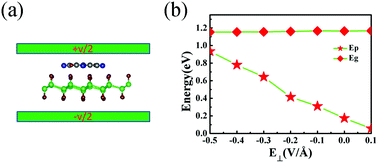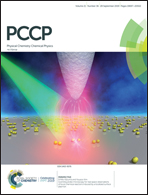Electric-field-tunable molecular adsorption on germanane†
Abstract
Fully-hydrogenated germanene, named germanane, represents a new nanostructured material for a variety of potential applications, such as electronics and optoelectronics. However, a critical requirement for developing practical and reliable electronic devices based on germanane consists of achieving a flexibly controllable charge carrier and doping level. Different to the conventional doping methods such as ion implantation and diffusion, by first-principles calculations we demonstrate that tetracyanobenzene (TCNB) molecular adsorption could introduce effective p-type doping in germanane due to the combination of germanane with electroactive acceptor molecule TCNB. The corresponding energy difference between the empty band minimum of the dopant and the valence band maximum for electron excitation is 0.173 eV. More importantly, this nondestructive p-type doping could be linearly tuned under an external E-field. Analysis of charge transfer by means of the equivalent capacitor model and the shift of energy levels in the superstructure of germanane/TCNB further reveals that the superposition of the external E-field and molecular adsorption-induced internal E-field plays a key role in the charge transfer between TCNB and germanane, especially in achieving a controllable p-type molecular doping level in germanane. Such convenient and flexible E-field-engineering of p-type molecular doping in germanane would be very helpful for potential applications of germanane-based electronic and optoelectronic devices in the future.



 Please wait while we load your content...
Please wait while we load your content...